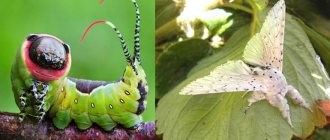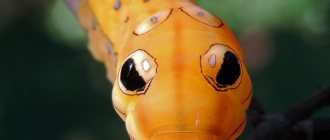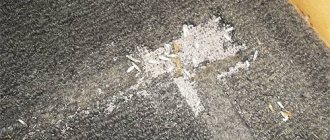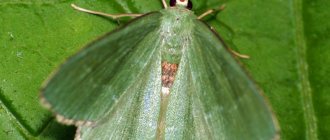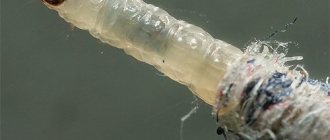Ecology
Moths and butterflies belong to the same order - Lepidoptera
. These insects got their name due to the scales on their wings. 89-94 percent of all known Lepidoptera are moths, and only 6-11 percent are butterflies.
According to the Library of Congress, “One of the easiest ways to tell a butterfly from a moth is to look at the antennae. Butterflies' antennae have thickenings at one end of a long stem. Moths have hairy or serrated antennae."
. We invite you to learn about the most unusual and beautiful moths and butterflies, the existence of which you probably had no idea at all.
1) Poodle Moth
The Venezuelan poodle moth, which was discovered by chance in 2009, has not yet been classified as a new species because scientists are not yet sure how to classify it. Since no one has described such a butterfly before, scientists are trying to trace the evolutionary stages of this insect.
These moths are highly hairy; their legs and wings are covered with tiny hairs, which makes them look like woolly animals, such as poodle dogs, hence the name.
Features of the lifestyle of meadow moths
Meadow moths are common insects.
Meadow moths are crepuscular butterflies and are active after sunset. Adults feed on plant nectar. And their lifespan is only 4-20 days.
The habitat of meadow moths is very wide, covering vast areas of North America, Europe and Asia. The largest colonies of these butterflies are found in forest-steppe and steppe areas.
A winged individual of the meadow moth.
As noted, these butterflies are highly fertile - they can reproduce in huge numbers, causing damage to farmland. Small meadow moths are able to move considerable distances using air currents. When a large number of meadow moths fly, it seems as if snow is falling, which is why the butterflies began to be called “blizzards”, in addition they are called motilits and bloodworms.
The diet of caterpillars consists of any terrestrial parts of plants on which they settle. When the caterpillars completely destroy one plant, they crawl to a new one. Caterpillars of meadow moths are highly mobile; they are able to cover about 60 meters in just an hour.
4) Saturnia cecropia
Saturnia cecropia (lat. Hyalophora cecropia
) mainly feeds on maple leaves while still a caterpillar. With a wingspan of up to 12 centimeters, this moth is the largest in North America. Like many other moths, cecropia is nocturnal and is very rarely seen during the daytime.
Reproduction of meadow moths
One female meadow moth brings about 300-600 eggs; she lays eggs on the lower surface of leaves. After 15 days, the eggs hatch into larvae, which molt 5 times and turn into caterpillars. Over the course of 2-4 weeks, the caterpillars develop and actively feed.
The fertility of meadow moths is a serious threat to crops.
At the last stage of development, the caterpillars make vertical holes in the ground, in which they weave cocoons and pupate. Pupae develop in about 4 weeks. After this period, a young meadow moth flies out of the cocoon, and after a few days it is ready to lay new eggs.
During a season, 1-4 generations of meadow moths can develop. The latest generation of caterpillars overwinter in cocoons located in the upper layers of the soil. Surprisingly, the caterpillars are very hardy; they are not afraid of even 30-degree frosts. At the end of winter, the caterpillars pupate, and young butterflies appear in May.
7) King Walnut Moth
Royal nut moth (lat. Citheronia regalis
), also known as royal citheronia. These insects are common in southern North America and have also been seen in the New York area. They do not boast the largest wingspan (only 10 centimeters), but by weight they are considered the largest moths in northern Mexico.
Description of the appearance of meadow moths
Meadow moth (Loxostege sticticalis).
The color of the front wings of the meadow moth is gray-brown, brown spots are scattered over the entire surface of the wings, and a yellowish stripe borders the outer edge. The hind wings are gray.
Females are larger than males - the wingspan of females reaches 26 millimeters, and that of males is approximately 20 millimeters. The antennae of males are serrated, while those of females are thread-like.
The caterpillar's body length reaches 35 millimeters. The body color is greenish, and a characteristic feature is a languid stripe running along the back.
Benefits and harms
The main benefit of moths is that they pollinate plants. Sitting on a flower to drink nectar, the insect stains its paws with pollen, and then transfers it to other plants.
As for harm, adult moths cause it only by laying eggs, from which larvae hatch after a short time. It is the caterpillars that are pests and cause serious damage to wild plants, agricultural crops, and some types of grain and vegetable stocks in storage, food and things in houses and apartments.
Yet the vast majority of caterpillars feed on plants, destroying leaves, shoots, bark, roots and even wood.
What harm does an insect cause?
Meadow moths are classified as a group of especially dangerous pests. They can cause enormous damage to agriculture. Moreover, both adult individuals and caterpillars at all stages of development are dangerous.
Butterflies feed on nectar and can seriously compete with honey bees. It has been noticed that where a large population of meadow moths flies, honey collection in apiaries noticeably decreases.
However, the greatest danger is the offspring of the butterfly . Caterpillars of the initial stage of development devour plant seedlings, enveloping them in cobwebs and turning them into skeletons. The older caterpillars eat everything in their path, leaving only the central veins and cuttings of the plant. A large colony of meadow moth caterpillars can destroy a gardener's entire crop in two days.
The diet of voracious insects includes 200 species of plants. The meadow moth's favorite food is weeds and sugar beets. With no less pleasure, the caterpillars eat corn, sunflowers, millet, hops, vegetables, alfalfa, buckwheat, clover, legumes and other crops. The pest does not ignore young tree seedlings either.
If there are up to 6 moth caterpillars on each plant, sugar beet yield can be reduced by 50–60%. If there are 20 caterpillars on a plant, the crops can be destroyed in a few days, and in hot weather, in a few hours. At high temperatures, caterpillars lose a lot of water, so they compensate for the loss by feeding heavily.
Chalcids are small parasitic insects that are effective in pest control. The green grasshopper is a predatory insect, but in the absence of protein food it can feed on various agricultural crops. Read this article for a full description of the insect.
Have codling moth caterpillars ruined all your apples? Find out how to overcome this pest by following the link https://stopvreditel.ru/rastenij/selxoz/yablonevaya-plodozhorka.html.
What do moths eat in the wild?
There are many varieties of lepidoptera, the adults of which do not eat at all. Their vital activity is supported by nutrients that were accumulated at the caterpillar stage.
Other moths feed on:
- nectar;
- overripe fruits;
- plant juice;
- honey.
Rare species consume the tears and blood of certain animals, as well as their excrement and sweat.
If you breed moths at home, you can prepare a nectar substitute. It can be any sweet liquid. The easiest way is to dilute a little sugar, honey or jam in water. Ripe juicy fruits are also suitable.
Peacock-eye Atlas
It is worth noting that female Atlas Peacock-eyes are much larger than males. Individuals feed on leaves of bushes and trees. And like previous record holders, they lead a nocturnal lifestyle. They are especially active during twilight, early morning and late evening, which is why they received the nickname “Prince of Darkness.” And the best way to observe the largest butterflies in the world is not in person, but in photographs. However, residents of Russia can see the beauty without leaving the country - Atlas Peacock-Eyed is bred in the Moscow Zoo.
By the way, the Atlas Peacock-eye species itself is quite interesting. During mating periods, a male can detect a female at a distance of up to several kilometers. And the mating itself lasts several hours without interruption. Immediately after emerging from the pupa, both the male and female are ready to reproduce. Peacock-eyes are unusually patient; females can wait for their male for several hours, while sitting motionless in one place, while the male will look for her at this time. And it is precisely this process, that is, reproduction, that is the meaning of life for the largest butterfly in the world. By the way, the life of a female is quite short. She dies immediately after laying offspring.
By the way, in Taiwan, Peacock Eyes without knowing it benefit people. People use caterpillar cocoons as wallets.
The largest butterfly in the world amazes with its beauty. The winged individual can be colored in bright red, yellow, pink and brown shades. And on each wing of the butterfly there are large triangular transparent “windows”. The front wings have a rather bizarre curved edge, which in shape and color resembles a snake's head. This is what the Peacock Eye scares away insectivorous animals. By the way, in Hong Kong, for this unusual feature, Atlas was nicknamed “The Moth - the head of a snake.”
In addition to its size, Peacock-Eyes has one more feature - its mouth is completely atrophied. Throughout its short life (only 1-2 weeks), the butterfly does not feed on anything, but processes all the fat reserves that it accumulated as a caterpillar.
By the way, the caterpillars of the giant butterfly are also huge - they grow up to 10 centimeters in length. And their appearance is original - they are light green in color with large blue processes throughout the body, which are covered with a waxy white coating (similar to powder).
Peacock-eye Atlas is not only a beautiful, but also a useful butterfly. In India, it is bred on special farms where fagar silk is obtained. It differs from the silkworm product in its wooliness, strength and durability.
Why do butterflies strive for light?
Very often on a summer evening you can see clouds of insects swarming around a lit lamp or a burning fire. Among those who fly into the light, and often die in the flames or sitting on hot glass, there are many night moths.
Today, there are several versions of why moths fly into the light, and scientists cannot decide which one is the most likely.
As you know, light is a guide for insects
They use it to determine where to move, no matter whether the moon or a street lamp is shining.
Another version is that since butterflies usually still focus on global sources, for example, the light of the sun or other celestial bodies, the movement of the insect does not in any way affect the distance to the star, and, accordingly, the brightness of the light. If a moth flies into the light of a lamp, then as it approaches the light source it becomes disoriented and can no longer get out of the illuminated circle.
Fighting methods
Outbreaks of mass butterfly appearances occur approximately every 8 or 10 years. Hordes of caterpillars are able to crawl from one area to another, eating everything in their path. The most favorable conditions for moth breeding are a temperature of about 17 °C and sufficient rainfall.
Dry weather reduces the butterfly population - during drought they remain infertile.
The fight against mass reproduction of the meadow moth begins with monitoring. In agricultural lands, bloodworm accumulations are monitored, and if their numbers grow alarmingly, comprehensive measures are taken to protect crops from caterpillar infestation. The fight against the meadow moth is carried out using several methods.
Agrotechnical method
With this method, deep plowing of the soil is carried out in early spring. Caterpillars in pupae end up deep in the soil and die en masse.
We also mow and destroy weeds in fields, along roads, fences and greenhouses: the butterfly prefers to lay eggs on weeds.
In addition, loosening, digging between rows, and hilling of plants are carried out.
Mechanical method
This method is effective in small areas. Caterpillars and laid eggs are collected from plants by hand, followed by removal of weeds from the beds.
It is important to know that if you remove weeds along with the caterpillars, the larvae may accidentally end up on healthy plants. It has been noticed that the fewer weeds growing in the beds, the lower the number of meadow moth caterpillars.
Biological method
The moth population size is significantly
reduce entomophages - natural enemies of the pest.
Before the start of summer, butterflies are released into the fields with Trichogramma, a parasite that lives in the eggs of bloodworms. Its release rates are set depending on the size of the butterfly population and their fertility. Trichogramma is released 2 or 3 times with an interval of 4 or 5 days.
Also reducing the number of caterpillars and pupae are parasites such as tahina flies and ichneumon ichneumon larvae.
Ground beetles and birds also contribute to saving the crop.
The biological preparations “Bitoxibacillin” (2 kg per 1 ha) and “Lepidocid” (0.6–1 kg per 1 ha) also effectively destroy caterpillars.
Chemical method
If, during a mass accumulation of moths per 1 sq. m there are from 5 to 10 caterpillars, chemical control measures are used. Crop processing is carried out using air or ground transport in the morning or evening.
Chemicals are most effective against young caterpillars. Older caterpillars are more resistant to insecticides.
The following drugs showed the greatest effectiveness:
- Fufanon - from 0.6 to 1 l per 1 ha;
- Metaphos (20%) - from 0.5 to 1.5 l per 1 ha;
- Phosfamide (40%) - from 0.5 to 1 l per 1 ha;
- Karbofos - from 0.6 to 1 l per 1 ha;
- Decis - 0.25 l per 1 ha.
The meadow moth causes truly irreparable harm to agriculture. However, constant monitoring, timely protective measures and tireless fight against a dangerous pest can strike back and save the crop.
Conversion process
Depending on the climate zone, as well as the type of insect, the process of degeneration can take from 2 days to 14 years. In our regions this process takes up to 2 weeks.
The transformation process itself is called metamorphosis, or more precisely, holometamorphosis, since the larva does not transform completely and some parts remain from it, mainly the paws. This term characterizes the complete transformation (degeneration) of forms, just as a glass or other forms are obtained from a melted bottle, which are radically different from the shape of the bottle.
Although the cocoon always remains motionless in appearance, quite complex and unique processes take place inside it. The caterpillar's body acquires a liquid consistency with imaginal discs, which essentially represent stem cells. These cells are unique in that they subsequently form various tissues and organs of the moth.
When the process is completed and the butterfly is already in the cocoon, it secretes a special substance that allows it to get rid of the cocoon. The head emerges from the cocoon first, then the body, and finally the legs. After birth, the butterfly sits motionless for some time and waits for its wings to dry. After which she goes on a journey to find herself a representative of the opposite sex. After mating, the butterfly will lay eggs, from which larvae will appear, etc.
Amazing transformation
Watch this video on YouTube
How to feed butterflies
The insects themselves cannot see and fly up to the treat. If the taste buds have not worked, then it is recommended to help them. Take a toothpick and slowly spin the proboscis with it, pointing it towards the food. There is no point in holding the butterfly. During feeding, you can see the proboscis moving more intensely. After the insect has eaten, it simply flies away.
To the question “What do butterflies eat?” one could answer briefly - nectar. They love the nectar produced by various beautiful flowers. Moreover, unlike many insects, butterflies distinguish the color red, which allows them to better navigate in search of food.
And in today’s article we will talk in detail about what butterflies eat at home and how they survive in the wild.
Scoop eggs
What do they look like?
The eggs are spherical or hemispherical in shape. The top is rounded, the bottom is flattened. The diameter varies from 0.4 to 0.9 mm. The color is most often light - it can be white, cream, light yellow, greenish, blue, pale brown.
The surface is usually ribbed and shiny, sometimes cellular. As they develop, the eggs may darken and change color. For example, bollworm eggs become almost black shortly before the larva emerges.
See photo for what cutworm eggs look like.
Where does it go?
The female hides the eggs, placing them on the ground, in plant debris, on the inside of leaf blades of food or weed plants. The shape of the masonry is irregular and asymmetrical. May be in the form of spots, winding rows and lines.
For additional protection, the female covers the eggs with her own hairs and scales or secretions of special glands.
What is the quantity in the clutch?
Female cutworms are famous for their fertility for good reason. One adult produces from 2 hundred to 3 thousand eggs during its short life. She lays eggs daily, placing them singly or in groups. A clutch can include from 2 to 150 eggs. The quantity depends on the type.
For example, the cabbage cutworm lays a clutch of 100 eggs, and the gamma cutworm lays eggs one or two at a time, with a maximum of 5.
